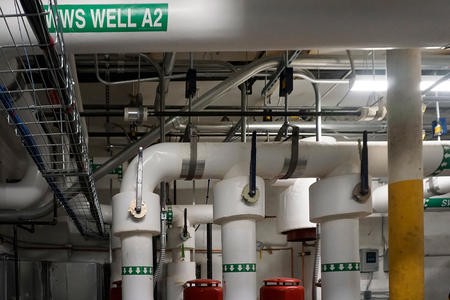The Colorado State Capitol building is the first state capitol in the country to be cooled by geothermal power, completed in 2013. An energy performance contract issued in June 2012 by the Colorado Department of Personnel & Administration and Chevron Energy Solutions allowed the upgrade of the Capitol's HVAC system and installation of a geothermal well that heats and cools the House and Senate Chambers. The geothermal project was part of a larger energy performance contract that began in 2003, which included reduction in electrical, steam and water usage in all 19 of the Capitol Complex buildings and was designed to realize a total of $29 million in energy conservation savings.
In addition to the upgraded functionality of air conditioning to portions of the building, the project replaced pumps and other equipment that dated back to the 1940s and was well beyond its estimated useful life, avoiding approximately $904,000 in replacement costs. Cooling was added to both the Senate and House Chambers through existing duct systems. The geothermal system also reduces the main chiller loop load by approximately 200 tons per year.
"The construction of a geothermal well at the State Capitol demonstrates Colorado's continued commitment to smart energy use," said Kathy Nesbitt, Executive Director of the Department of Personnel & Administration. This project illustrates that you can offset energy usage and improve functionality while making necessary HVAC system repairs."
The U.S. Department of Energy (DOE) provided a $4.4 million demonstration grant toward the overall $6.6 million project. The State financed the remaining $2.2 million through a 15-year lease/purchase realized through guaranteed cost avoidance of $2 million and other in-kind contributions to complete the project.
"Colorado has been a national trend-setter in deploying clean energy technologies, which will be critical to ensuring America's global competitiveness," said Dr. David Danielson, the Department of Energy‚ Assistant Secretary for Energy Efficiency and Renewable Energy. "Retrofitting public facilities to operate with renewable energy helps strengthen our economy, saves taxpayers money over the long term and helps reduce pollution. This project serves as a good example of how communities across the country can improve the energy performance of their state and government buildings."
The Colorado State Capitol has been LEED® certified to the Gold level since 2008. The U.S. Green Building Council's LEED® green building program is the preeminent program for the design, construction, maintenance and operations of high-performance green buildings. Learn more at usgbc.org/LEED.
Fact Sheet
June 10, 2014 - The Capitol Geothermal Project Story
The Colorado State Capitol building is the first state capitol in the country to be cooled with a geothermal system (the Idaho capitol is heated by a geothermal hot spring). The geothermal project was completed in 2013. The capitol geothermal project was just one part of a larger DPA/Capitol Complex energy performance contract started in 2003. The entire energy performance contract, including reduction in electrical, steam and water usage in all 19 of the Capitol Complex buildings, is designed to realize a total of $29 million in energy conservation savings.
The Geothermal Well System
The geothermal system uses an open loop 2 well system. Two wells were drilled to a depth of 850 feet. The wells are located on the NE and SE quadrants of the capitol. Constant 65 degree water is pumped up from one well, channeled through a heat exchanger, and then returned to the aquifer through the second well. The system is designed so water can be pumped from well A to well B, or from well B to well A, and is 100% redundant. Maximum pumping volume from each well will be 300 – 350 GPM at peak load periods. The expected life of the well system is 100+ years; the expected life of the well pumps is 20 years.
The Geothermal Heat Pump System
The project replaced HVAC system equipment that is anywhere from 25 to 70 years old throughout the capitol without affecting existing ductwork. Cooling was added to both the Senate and House Chambers through existing duct systems. The geothermal system also reduces the main chiller loop load by approximately 200 tons per year. The upgrades include:
- Installing updated controls
- Demolishing and replace 28 air handlers in the State Capitol
- Removal of HVAC steam systems, and
- Adding air conditioning to the House and Senate Chambers
The Geothermal Project Finance
The actual geothermal project cost is approximately $6.6 million. This amount is achieved through two principle means:
- $4.4 million via a Department of Energy "Demonstration Project" Program Grant, and
- $2.2 million via DPA 15-year lease/purchase realized through guaranteed cost avoidance ($2.0 million) and other in-kind contributions throughout the project ($200,000).
